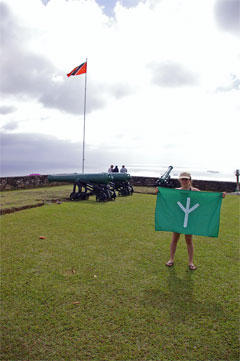 |
Le drapeau fomoire est déployé à Fort George, petit fortin situé dans les collines qui dominent Port d'Espagne, la capitale de Trinité et Tobago. The Formori flag is deployed on Fort George, a little stronghold in the hills that dominates Port-of-Spain, the capital of Trinidad and Tobago. |
|
Les couleurs de Trinité et Tobago flottent haut sur Fort George. Officiellement, la couleur rouge représente "le soleil et la générosité du peuple", le blanc "la mer et l'égalité entre les hommes", tandis que le noir est "la ténacité et la vocation de l'unité". Pourquoi pas ? The flag of Trinidad and Tobago flies high above Fort George. Officially, the red colour stands for "sunlight and people's generosity", the white is for "the sea and equality between men" and the black represents "tenacity and vocation for unity". Why not? |
 |
 |
La ville de Port d'Espagne au pied de Fort George où flottent fièrement les couleurs fomoires, nullement intimidées par les canons anglais. The city of Port-of-Spain lies down below Fort George where the Formori colours are proudly floatting, not intimidated at all by the British cannons. |
|
| L'entrée du quartier St James à Port d'Espagne. On y reconnaît la symbolique coquille, chère aux Fomoires. The entrance to the St. James quarter in Port-of-Spain. It features the famous shell which also holds some symblic value for the Formoris. |
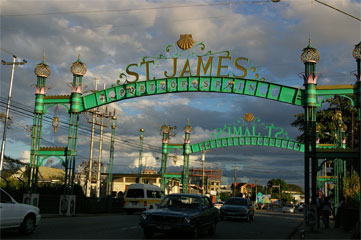 |
|
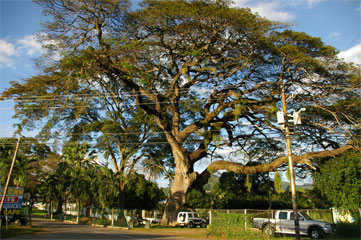 |
Un magnifique couroupita, ou "cannonball tree", dans un parc de Port d'Espagne. A magnificent couroupita, also known as the "cannonball tree", in a park of Port-of-Spain. |
|
Le surnom du couroupita lui vient de ses fruits qui évoquent des boulets de canon. The couroupita's nickname comes from its cannonball-shaped (and sized) fruits. |
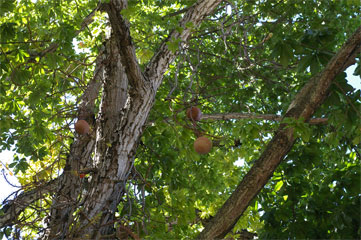 |
|
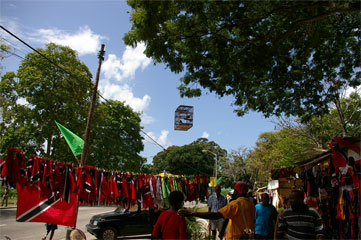 |
Un oiseau en cage chante à la terrasse d'une échoppe au bord de la Savannah, le plus grand rond-point du monde (plus de 4 km pour en faire le tour). A bird in a cage sings above the terrace of a tiny shop on the edge of the Savannah, the world's largest roundabout (more than 4 km to circle it). |
|
Les écheveaux de câbles aériens sont souvent colonisés par des broméliacées. Il n'est pas rare de voir des orchidées pousser sur les lignes téléphoniques. The web of aerial cables is often colonised by bromeliaceae.It is not uncommon to see orchids growing on the phone lines. |
 |
|
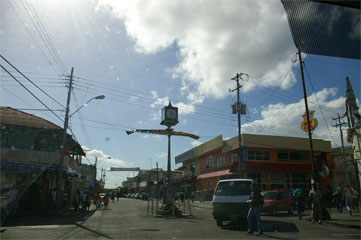 |
Le plus fameux monument d'Arima, troisième ville de l'île : son horloge coloniale, surnommée "Le Cadran" ("The Dial"). Il fallait le savoir ! The most famous landmark in Arima, the third city of the island, is "the Dial", its colonial clock. Really a "must see"! |
|
Un aperçu de la "Cathédrale de Bambous" de Macqueripe, une réserve naturelle dans la pointe nord-ouest de l'île. A glimpse into the "Bamboo Cathedral" of the Macqueripe natural park, in the north-western part of the island. |
 |
|
 |
Des séchoirs à café avec leur toit amovible monté sur rail, dans la réserve naturelle du centre Asa Wright, au nord d'Arima. Coffee dryers with their rail-mounted movable roofs, in the Asa Wright Nature Center, North of Arima. |
|
A l'intérieur, les graines de café sont mises à sécher, ce qui n'a rien d'évident dans cette atmosphère moite. Inside, the coffee grains are let to dry, which is not easy in such a moisterized atmosphere. |
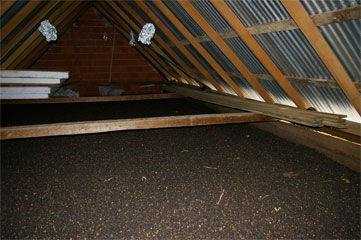 |
|
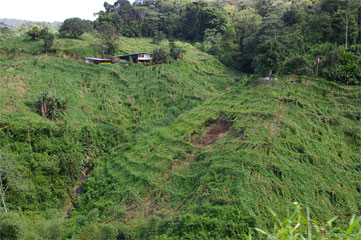 |
La culture des christophines (aussi connues sous le nom de "chatottes") se fait sous des filets tendus à flanc de coteau, comme ici dans la vallée d'Arima, qui semble recouverte d'un immense filet de camouflage. The culture of christophenes (also known as "chayottes") is done under nets hung on the hillside, like here in the Arima valley, which seems to be covered with a giant camouflage net. |
|
L'île de Saut d'Eau, sur le rivage nord, est un sanctuaire à oiseaux. Saut d'Eau island, on the northern shore, is a bird sanctuary. |
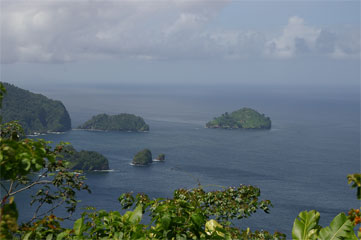 |
|
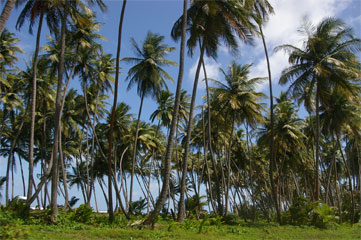 |
La magnifique cocoteraie de Manzanilla, sur la côte est, est hélas très mal entretenue et parfois même défrichée par des squatters qui construisent des villas en toute illégalité. The wonderful coconut tree forest of Manzanilla, on the East coast is unfortunately left mostly unattended. Squatters even clear parts of it to build villas in total disrespect of the law and of the nature. |
|
La forêt primaire recelle une grande variété de plantes dont ces étranges lianes hélicoïdales, aperçues dans la réserve naturelle du centre Asa Wright. The rainforest houses a wide variety of plants such as these helix-shaped liana, seen in the Asa Wright Nature Center. |
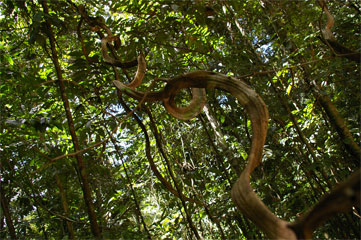 |
|
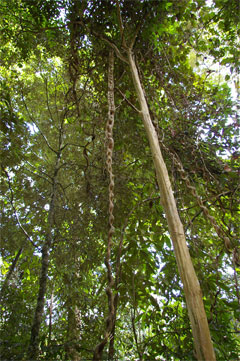 |
Une autre variété de liane, toujours dans la splendide réserve naturelle du centre Asa Wright. Another variety of liana, again in the very picturesque Asa Wright Nature Center. |
|
| Des cocotiers dans le vent à Maracas Bay, une des plages de la côte nord, et l'un des endroits les plus sympathiques pour déguster la spécialité locale : des beignets de requin ! Coconut trees in the wind above Mracas Bay, one of the beaches on the northern coast and a very pleasant place to taste the local seafood specialty: baken shark! |
 |
|
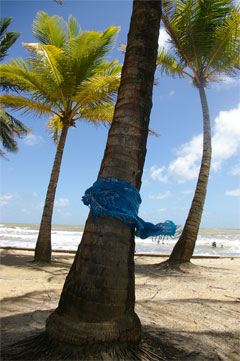 |
Un pareo sêche dans le vent sur un cocotier à Manzanilla Bay, une plage de la côte est, dont les rouleaux attirent les surfers et les courants traîtres rappellent les "bahines" landaises. A pareo is drying on a coconut tree in Manzanilla Bay, another beach on the East coast, with roller waves attracting surfers and treacherous currents that can drown you a few metres from the shore. |
Le drapeau au Carnaval ! - The Flag Goes to Carnival!
